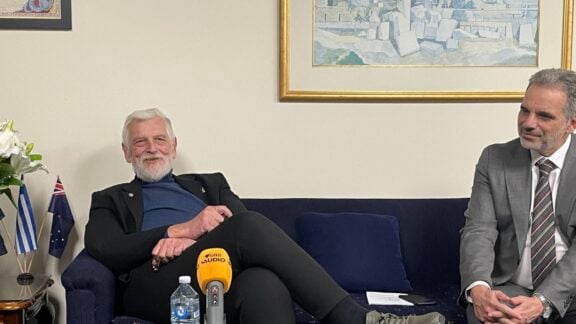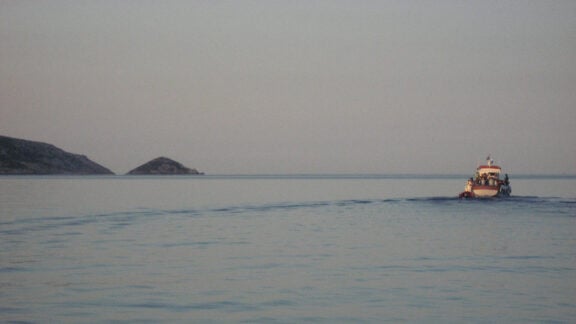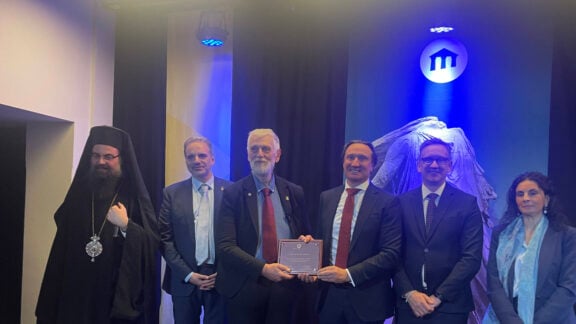April will see the unique From Imbros Over the Sea pictorial exhibition brought to Sydney as part of the Greek Festival of Sydney. This is its first showing since its Melbourne launch last year.
The exhibition reveals the story of the role of the northern Aegean Island of Imbros and its Hellenic population in the Gallipoli campaign through the reproduction of many archival photographs and artworks, all explained by accompanying historical text and specially created maps. The exhibition consists of a number of large panels, devoted to the particular themes of Imbros’ involvement. The associated exhibition guide book will also available for purchase at the exhibition. This 132-page book tells the Imbros-Gallipoli story in more detail, with references for further reading and illustrated with 80 photographs and 3 original maps from the exhibition.
The exhibition was created by the Imvrian Society of Melbourne, with the support of the Victorian Government and Victorian Veterans Council. The exhibition itself was researched and curated by Melbourne historian Jim Claven OAM who has been researching the role of Imbros in the campaign for over 8 years. Mr Claven is the author of the books Lemnos & Gallipoli Revealed as well as From Imbros Over the Sea.

Mr Claven pointed out that his research reveals that Imbros (now Gokceada, Turkey) played a significant but little appreciated role in the campaign of 1915-16. Its Kephalos Bay, being the closest harbour to Anzac Cove, was the rendezvous point for the landings on 25th April and a major harbour throughout the campaign. Imbros was a key transit point for Australian and Allied troops being shipped to and from the Peninsula. It was a major base for Allied air units, with aeroplanes, kite-balloons ships and a large hydrogen filled airship based there. It also served this purpose for many wounded and sick soldiers, some of whom were treated in the field medical units based there. Those who came to Imbros were subjected to enemy attack, by enemy bombardment as well as the threat posed by naval attack as Allied ships came and went from the island’s anchorage.

He also explains in the exhibition that a number of Australian military units were based on Imbros. These ranged from important Australian figures such as Colonel John Monash and correspondent Charles Bean as well as a number of military units that played significant parts in the campaign such has the 1st Australian Field Bakery. Australian troops also formed a guard for the Allied Headquarters on Imbros. Many Australian troops came to Imbros for rest and recuperation.
Mr Claven said that some of the most poignant images are those depicting the interaction of the soldiers with the local Greek community, such as that taken Australian Private John David Rogers of the 6th Battalion in January 1916 depicting Australian soldiers dancing with local children in an unidentified village on Imbros.

“My research reveals that Australian and other Allied soldiers met locals on the shore or at their camps, partook of its produce, roamed the Island, visiting its villages and churches, stayed in their local inns and relaxed in its natural environment, enjoying a respite from the horrors of war. As on Lemnos, this created an important cultural connection between the Islands overwhelmingly Hellenic population and these young soldiers, a number of them Australian”, Mr Claven said.
The exhibition consists of a series of large panels, arranged around a series of key themes, displaying archival photographs of Imbros taken by Australians and other Allied service personnel during the campaign, placed in context with text explaining the key aspects of Imbros’ role in the Gallipoli story.

The exhibition also displays some of the many artworks depicting the Island and its role in the campaign produced on Imbros by Allied soldiers. The exhibition concludes with the reproduction of Mr Claven’s own photographs of many of the same scenes today, taken during his field research trips to Imbros. Original maps have also been created, drawing on archival maps from the campaign held in the National Archives in London and Mr Claven’s historical research. These enable the viewer to easily locate the sites referred to in the exhibition panels.
Mr Claven said that his archival research has uncovered many photographs from the time, taken by Australian and other Allied service personnel which vividly bring to life this story from Imbros’ past.

“It was seeing many of these images for the first time a few years ago that sparked my desire to conduct field research on the Island, which I was able to undertake in 2015, during the Centenary of Anzac”, Mr Claven said.
He added that like the story of the nearby Island of Lemnos and its connection to Anzac, the scenes and vistas of Imbros in some respects have remained the same and almost appear to communicate with the commemorative viewer over the decades. Many of the sites on Imbros connected to the Anzacs and the broader Gallipoli story have been untouched by the passage of time.
The Imvrians’ Society of Melbourne is a community group of descendants and friends of the island of Imbros. The organization was formed in 1970 and is located in Mentone. The Society’s project officer, Mr George Xinos, worked with Mr Claven on the exhibition project, playing a key role in laying out the exhibition panels and the creation of the exhibition maps.

Mr Xinos said that the launch is only the beginning for the project, with hopes that the exhibition will go on to be displayed at other Victorian venues and throughout Australia, as well as overseas, hopefully on Imbros itself.
“The aim of this project is to raise awareness and to begin a conversation on how we can appropriately remember and commemorate this important part of the Island and Australia’s history. As Mr Claven has informed us, every year tens of thousands of Australians visit the battlefields and graves on the Gallipoli Peninsula. We want to work to promote and help create a Gallipoli Heritage Trail on Imbros, emulating that recently begun on Lemnos, to encourage new visitors to Imbros,” Mr Xinos said.
Mr Xinos pointed out that recent years have seen a resurgence of Greek community life on Imbros, with the permanent population growing from200 a few years ago to now approaching 600. Primary and Secondary Schools have been established, catering for the local Greek community children. These developments have been supported by the local authorities and the Greek Orthodox Patriarchate – many will be aware that the Patriarch Bartholomew is also a native of the Island.

Mr Claven thanks the Imvrian Society of Melbourne for its foresight in supporting this project. He also wishes to thank the First World War Aviation Society in the United Kingdom for its generosity in allowing the reproduction of many photographs from its collection. He also places on record his thanks to Mr David Sanderson of the Brotherhood of Greek Campaign Veterans in the United Kingdom for his assistance in accessing the original campaign maps of Imbros held by the National Archives in London.
The exhibition is scheduled to be shown at the Prince Henry Centre, 2 Coast Hospital Road, Little Bay, on 7th April. The presentation on the exhibition will commence at 4pm and will be in English.
Readers interested in attending the presentation and viewing this important exhibition should book their free tickets in advance. Bookings here.
Those interested in purchasing the exhibition guide book should contact George Xinos – georgexinos@gmail.com









